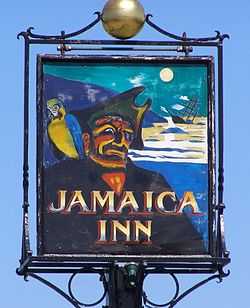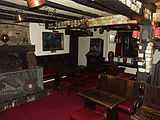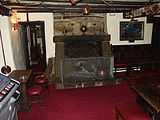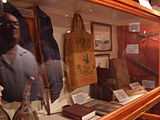Jamaica Inn
| Jamaica Inn | |
|---|---|
 | |
|
Jamaica Inn | |
| General information | |
| Location | Bolventor, Cornwall, England, UK |
| Coordinates | 50°33′44″N 4°34′01″W / 50.56222°N 4.56694°W |
| Opening | 1750 |
Jamaica Inn is a traditional inn on Bodmin Moor in Cornwall, United Kingdom.[1][2] Built as a coaching inn in 1750, and having an association with smuggling, it was the setting for Daphne du Maurier's 1936 novel Jamaica Inn,[3] which was made into the film Jamaica Inn in 1939 by Alfred Hitchcock.
Located just off the A30, near the middle of the moor close to the hamlet of Bolventor,[2] it was used as a staging post for changing horses.[1] The inn is alleged to be one of the most haunted places in Great Britain. Daphne du Maurier wrote her novel in 1930 when, having gone horse riding on the moors, she became lost in thick fog and sought refuge at the inn.[1] During the time spent recovering from her ordeal, the local rector is said to have entertained her with ghost stories and tales of smuggling; he would later become the inspiration for the enigmatic character of the Vicar of Altarnun.
As well as the Hitchcock film, there has been a 1983 television series, Jamaica Inn, starring Jane Seymour, and a television adaptation in 2014 starring Jessica Brown Findlay directed by Philippa Lowthorpe.[4] In addition to its use in literature, and film, the hotel is referenced in "Jamaica Inn", a song written by Tori Amos on her album The Beekeeper, written while she was travelling by car along the road of the Cornwall cliffs, and inspired by the legend she had heard of the inn.[5]
The inn became a Grade II listed building in 1988. The hill named Tuber or Two Barrows, 1,122 feet (342 m), is close-by.[6]
Location

Jamaica Inn is located on the bleak Bodmin Moor, near Bolventor. Brown Willy is situated 4 miles (6.4 km) to the north,[7] while Rough Tor is nearby, as are the valleys of Hantergantick and Hannon.[8] Dozmary Pool is situated 1.5 miles (2.4 km) south of the inn, while a branch of the Fowey estuary is .5 miles (0.80 km) to the west.[8] Spread over 0.75 acres (0.30 ha) of land,[9] the Jamaica Inn has been refurbished with a theme park face lift and functions as an exclusive bed and breakfast manor, with a pub, a museum and a gift shop. Bodmin is connected by road with St Austell, which is on the London-Penzance line.[10][11] The farm where British astronomer John Couch Adams was born is nearby.[8] Other landmarks include the Four-hole Cross, Peverell's Cross, the circular entrenchment of Cardinkam Bun, and the Knights Templar church ruins at Temple.[6] Between the inn and Kilmarth, a house near Par, can be found hut circles, stone lines and parts of ancient stream works.[12]
History
It is often commonly thought that the inn takes its name from the smugglers who smuggled rum into the country from Jamaica and stored it at the inn. However, the name of the inn is actually said to derive from the important local Trelawney family of landowners, of which two family members served as Governors of Jamaica in the 18th century.[13]
The inn was built in 1750 and extended in 1778 with a coach house, stables and a tack room assembled in an L-shaped fashion. The inn became a smugglers' stopping point while they used approximately 100 secret routes to move around their contraband.[14] Originally, the half-way house was alone on this part of the moor, but later a church, parsonage, and school were added by Mr. Kodd, the proprietor of the land, satisfying the area's residents.[6]
According to narrated story, gangs of wreckers operated on the coast of Cornwall during early 19th century. Cornwall has been very aptly described as the “haven of smugglers” in view of its topographic features of “rocky coves, sheltered bays, tumultuous waves and wild and untenanted landscapes”.[11] The wreckers ensnared ships to this coast line by tricking them with use of beacon lights, which they purposefully installed on the shores of the coast. Once the ships foundered on the rocky coast they were looted by the wreckers.[15]

By 1847, Francis Rodd of Trebartha Hall, who had been High Sheriff of Cornwall in 1845, was building a chapel at Bolventor to accommodate those who lived in the Jamaica Inn area.[16] In 1865, Murray wrote that the inn was frequented in the winter by sportsmen and offered only rudimentary accommodations.[8]
The current building still includes the extension of a coach house, stables and a tack room added in 1778.[1] The inn was owned for a period by the novelist Alistair MacLean.[17]
The Jamaica Inn’s past notoriety as the pirates' den was known to Du Maurier three years before she wrote her book, when she had lived in the inn, and on the basis of which she had spun her popular novel the “Jamaica Inn”, which was adopted into a melodramatic film of the same name made by Alfred Hitchcock. Before living in the inn, she had resided in Fowey estuary, known earlier as Foreside, a house in Bodinnick and subsequently in Menabilly.[18] She described the nocturnal activities of a smuggling ring based at the now celebrated inn, "portraying a hidden world as a place of tense excitement and claustrophobia of real peril and thrill.”[11] It should be noted though that in Du Maurier's novel, the Jamaica Inn is not functionable as an inn with many guests it had in reality, but was solely the home of the landlord and a rendezvous and storagehouse for smuggling. In the popular film made by Hitchcock in 1939 with the pirate's story line, the heroine’s role of a young girl who encounters the gangsters in the Jamaica Inn as “Lady Vanishes” was played by Maureen O’ Hara in her debut appearance while the main role of the ugly and fierce leader of the pirates was played by Laughton. The young girl finds out that her uncle is a member of the gang, and a young man accused of treason is about to be hanged. She soon cuts the noose around the young man and assists him to escape through the backdoor.[15]
Architecture and fittings
The two-storey building, constructed in the mid 18th century, had symmetrical front windows that were replaced in the 20th century. The slate roof is bitumen coated and has hipped ends. An extension with two additional rooms occurred in the 19th and 20th centuries. The central door and gabled porch are flanked by two light casements; all are attributed to the 20th century.[2] The building's exterior is made of dark slate and stone. It has a cobbled courtyard which features an old rusty anchor and a red telephone box.[19] Historically, however, the courtyard was gravel. The exterior to the Smuggler's Bar says, "Through these portals passed smugglers, wreckers, villains and murderers, but rest easy....t'was many years ago".
The interior is characterized by sloping floors with many of its original beams. Internal building partitions have been removed. The fireplaces display roughly cut granite lintels.[2] The Smuggler's Bar in particular retains its 18th century feel with its large granite fireplace in the bar and dark wood beams.[14][19] The bar area contains many old bank notes on the walls and various items such as brass or copper kettles and urns.
The Jamaica Inn became a Grade II listed building on November 23, 1988.[2]
-

Smuggler's Bar exterior
-

Interior
-

Granite fireplace
-

Bar area, with currency on the walls
Mr Potter’s Museum of Curiosities
Between 1984 and 2003, the building housed a large collection of stuffed animals in complex dioramas, such as an animal courthouse or school classroom populated by baby squirrels. Known as "Mr Potter’s Museum of Curiosities", these exhibits were created by Walter Potter in the 1850s, and were originally housed in his museum in Bramber, Sussex. The collection was auctioned by Bonhams in 2003 resulting in its dispersal.[20]
The Museum of Smuggling
The inn contains "The Museum of Smuggling", which is located to the western side of the inn and the main coaching house. A plaque on the walls outside says "The Museum of Smuggling. Presents a record of classical examples in the arts of concealment and evasion". The museum's main focus is its collection of smuggling artifacts that is depicted through the history of the Jamaica Inn and the inn's role in this trade for many years. The Cornwall coast was the most popular location for smuggling of silks, tea, tobacco and brandy into England and operated from the Cornish coast, Polperro (on the south coast) and Boscastle, Trebarwith and Tintagel on the north coast as this coastline was not well covered by the law enforcing authorities. Many of the smugglers stored their contraband in the isolated location of the Jamaica Inn. It is also said that even the judges were fairly lenient towards the smugglers, probably due to their receiving some of the smuggled goods.[21] The museum contains various items including "Wanted" posters, one of which is dated to 1798, a poster celebrating Lord Nelson's victory at the Battle of Trafalgar, various pottery figures of smugglers and villains, a bag of "10 pounds of Jamaican ganja" and old books etc. There is also a display in the room where the author Maurier lived of various items owned by her including her writing desk and typewriter.
-

Museum exterior
-

Exterior plaque
-

Bag of "10 pounds of Jamaican ganja"
-

Historical posters
Haunting

Reportedly haunted, the inn is described by its owners as having "resident ghosts" and as a place of "paranormal activities of dark deeds done in the night". According to the owners, the inn has been investigated by "The Ghost Society" and featured in an episode of the British TV programme Most Haunted, first aired on the TV channel LIVINGtv on April 6, 2004.[11][22] [23]
References
- ↑ 1.0 1.1 1.2 1.3 "Jamaica Inn, Cornwall". cornwall-calling.co.uk. Retrieved 24 December 2010.
- ↑ 2.0 2.1 2.2 2.3 2.4 "Jamaica Inn-Altarnun". British Listed Buildings. Retrieved December 27, 2010.
- ↑ Jean Paschke (March 2007). "The Cornwall of Daphne du Maurier". British Heritage (Weider History Group). p. 2. Retrieved 2007-11-11.
- ↑ "BBC1 – Jamaica Inn". BBC. Retrieved 23 April 2014.
- ↑ "About This Track: Tori Amos – Jamaica Inn". last.fm. Retrieved December 26, 2010.
- ↑ 6.0 6.1 6.2 Paris, Thomas Clifton (1859). A hand-book for travellers in Devon & Cornwall [by T.C. Paris]. pp. 166–.
- ↑ Berry, Oliver; Dixon, Belinda (15 February 2008). Devon, Cornwall & Southwest England. Lonely Planet. p. 276. ISBN 978-1-74104-873-5. Retrieved 24 December 2010.
- ↑ 8.0 8.1 8.2 8.3 Murray, John (1865). A handbook for travelers in Devon and Cornwall. J. Murray. pp. 206–. Retrieved 24 December 2010.
- ↑ Country life. Country Life, Ltd. 2006. Retrieved 26 December 2011.
- ↑ Else, David; Berry, Oliver (2005). Great Britain. Lonely Planet. p. 331. ISBN 978-1-74059-921-4. Retrieved 26 December 2010.
- ↑ 11.0 11.1 11.2 11.3 Cornwall Tourism. Cornwall Tourism Guide. Cornwall Tourism. p. 13. GGKEY:CH2WCKGTDN1. Retrieved 26 December 2011.
- ↑ Paris, p. 237
- ↑ "Jamaica Inn. Bolventor. Launceston. Cornwall". Huaunted Britain. Retrieved December 27, 2010.
- ↑ 14.0 14.1 Shalam, Sally (October 30, 2010). "Jamaica Inn Hotel". The Guardian. Retrieved 24 December 2010.
- ↑ 15.0 15.1 Time Inc (19 June 1939). LIFE. Time Inc. p. 67. ISSN 00243019. Retrieved 26 December 2010.
- ↑ The Cornwall register: containing collections relative to the past and present state of the 209 parishes, forming the county, archdeaconry, parliamentary divisions, and poor law unions of Cornwall ; to which is added a brief view of the adjoining towns and parishes in Devon, from Hartland to Plymouth. Printed by Liddell and Son. 1847. p. 271. Retrieved 24 December 2010.
- ↑ Macdonald, Gina (2003). Dictionary of Literary Biography: British Mystery and Thriller Writers since 1960. Gale. p. 236. OCLC 231975685.
- ↑ Else, David (2003). Britain. Lonely Planet. p. 413. ISBN 978-1-74059-338-0. Retrieved 26 December 2010.
- ↑ 19.0 19.1 James, Philip (1 June 2003). Cornwall: a county guide. Cv Publications. pp. 28–. ISBN 978-1-901161-43-4. Retrieved 25 December 2010.
- ↑ "Walter Potter’s amazing tableaux take centre stage". Retrieved 2010-02-10.
- ↑ "Daphne du Maurier's Smugglers Museum". Jamaica Inn. Retrieved December 26, 2010.
- ↑ "Ghosts and spooking goings on at Jamaica Inn". Jamaica Inn.co.uk. Retrieved December 26, 2010.
- ↑ Jamaica Inn, Most Haunted, LIVINGtv, April 6, 2004
